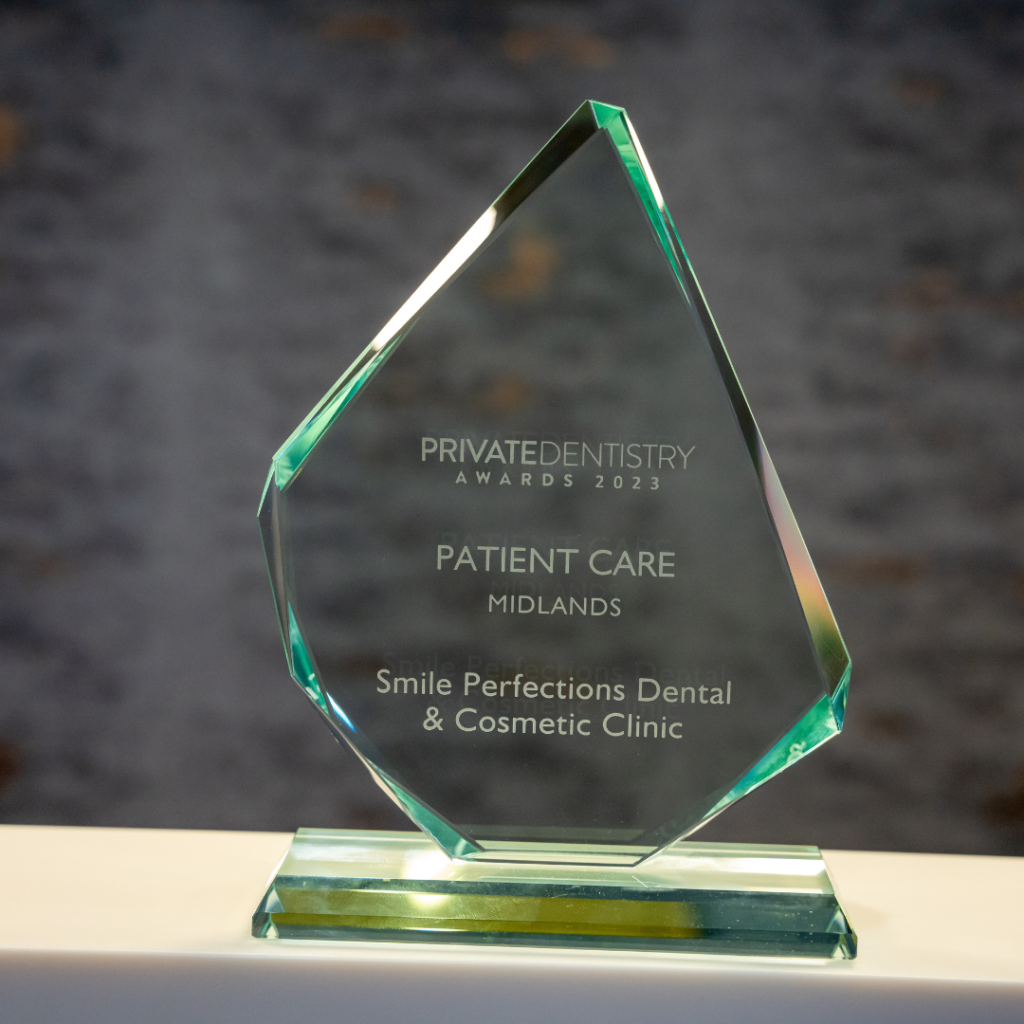Dental crowns explained: a clear guide from Smile Perfections
If you’ve been told you need a dental crown, you might have a few questions. What exactly is the dental crown procedure? Will it hurt? Are there any disadvantages of dental crowns? And what should you do if you experience dental crown soreness afterwards?
At Smile Perfections Dental Clinic in Leicester, we’ve helped hundreds of patients restore their teeth with natural-looking crowns that blend beautifully with their smiles. This guide walks you through every step — from why crowns are used, to what happens during treatment, and how to keep your crown comfortable for years to come.

What is a dental crown?
A dental crown is a protective cover that fits over a damaged or weakened tooth. It restores the tooth’s strength, shape and appearance. Crowns can be made from several materials, including porcelain, ceramic, metal, or a combination of both.
At Smile Perfections, we typically recommend crowns when a tooth is:
- Broken or cracked
- Severely worn down
- Weakened after a root canal treatment
- Discoloured or misshapen
- Holding a large filling
You can read a helpful overview of what a dental crown is on the Cleveland Clinic website.
When a dental crown is recommended
Your dentist might suggest a crown when there’s not enough natural tooth left to support a standard filling. Crowns also protect teeth after root canal treatment, preventing them from fracturing.
They’re often used alongside dental bridges to replace missing teeth, or for cosmetic improvements when whitening or bonding aren’t suitable.
The dental crown procedure: step-by-step
Patients often ask what happens during the dental crown procedure. The process usually takes two visits, though same-day options are available in some cases.
- Examination and preparation
We begin with a full dental check-up to assess the tooth and surrounding gums. If decay or old fillings are present, these are cleaned out. Sometimes, a root canal is needed first to stabilise the tooth.
- Shaping the tooth
The tooth is gently reshaped to make space for the crown. You’ll be given local anaesthetic, so this step is comfortable.
- Impression or scan
We take an impression or digital scan of your teeth. This ensures your crown fits precisely with your bite.
- Temporary crown
A temporary crown protects your tooth while your final one is made at the lab.
- Fitting your permanent crown
At your second appointment, we remove the temporary crown and bond your new, permanent crown in place using dental cement. The result is strong, natural-looking, and ready to use straight away.
You can also read a concise patient-friendly explanation of what to expect during a crown treatment on Colgate’s dental crown procedure page.
Does the procedure hurt?
Most patients are surprised at how straightforward it is. With modern anaesthetics and careful technique, the dental crown procedure is comfortable and pain-free.
Afterwards, you may notice mild dental crown soreness for a few days — usually from the gum adjusting around the new crown. This can be eased with gentle brushing, saltwater rinses and mild pain relief if needed.
If soreness lasts longer than a week, or if the crown feels high when biting, contact us for a quick adjustment.
Dental crowns alternatives. Which is right for you?
| Feature | Dental crown | Dental filling | Dental bridge |
|---|---|---|---|
| Best for | Heavily damaged, cracked or root-treated teeth needing full-coverage protection. | Small to medium cavities or chips where most tooth structure remains. | Replacing one (or more) missing teeth using neighbouring teeth as supports. |
| Strength & longevity | High strength; often 10–15+ years with good care. | Moderate; lifespan depends on size, position and bite forces. | High; fixed solution with reliable function when designed well. |
| Tooth preparation | Moderate: tooth reshaped all round to seat the crown. | Conservative: only the decayed or fractured area is restored. | Varies: conventional bridges prepare anchor teeth; adhesive (Maryland) bridges are minimal. |
| Aesthetics | Excellent with porcelain/zirconia; colour-matched to your smile. | Very good for smaller defects with modern tooth-coloured materials. | Excellent; custom shade/shape to blend with adjacent teeth. |
| Typical appointments | Usually 2 visits (prep + fit). Some cases can be same-day. | Often 1 visit. | Usually 2 visits (prep + fit) plus review of bite/cleaning access. |
| Maintenance | Brush and clean between teeth; avoid very hard foods; review at check-ups. | Standard home care; monitor for wear or margins at check-ups. | Clean under the bridge with floss threaders/superfloss or interdental brushes. |
| Notes | Great when a filling won’t last; protects and strengthens the tooth. | Cost-effective for limited damage; large fillings can fail under heavy load. | Restores function/aesthetics without surgery; depends on health of supporting teeth. |
Advantages and disadvantages of dental crowns
Crowns are one of the most reliable and widely used restorations in dentistry. Still, it’s sensible to understand both sides before deciding.
Advantages
- Strengthens and protects weak or cracked teeth
- Restores natural appearance and bite
- Long lifespan (typically 10–15 years or more)
- Custom-made for comfort and aesthetics
- Can be colour-matched to your surrounding teeth
Disadvantages of dental crowns
Like all treatments, crowns have some limitations:
- Tooth preparation involves removing a small amount of natural enamel
- May cause mild dental crown soreness initially
- Occasional risk of crown loosening if not maintained
- Metal-based crowns may show a thin grey line at the gum (for some materials)
- Crowns can wear down over time and eventually need replacing
We always discuss the disadvantages of dental crowns transparently before treatment, so you can make an informed decision that feels right for you.
Materials used for dental crowns
There are several types of crowns, and the right one depends on your needs and priorities.
| Material | Best for | Features |
|---|---|---|
| Porcelain | Front teeth | Natural colour match, smooth finish |
| Porcelain-fused-to-metal | All teeth | Strength + aesthetics |
| Ceramic | Front teeth | Metal-free, very natural |
| Metal alloy | Back teeth | Exceptional durability |
| Zirconia | All-round option | Very strong and aesthetic |
Your dentist will discuss which type suits your tooth position, bite strength and aesthetic goals.
For a broader overview of crown materials, you can also visit HealthDirect’s guide to the dental crown procedure.
Dental crown soreness: what’s normal and when to seek help
Some patients experience dental crown soreness after treatment — particularly in the first few days. This is usually due to:
- Temporary irritation to the gum
- Minor inflammation around the prepared tooth
- The bite settling after placement
To ease this:
- Rinse gently with warm saltwater twice daily
- Use a soft toothbrush around the crown
- Avoid very hard or sticky foods for a few days
- Take over-the-counter pain relief if needed
If pain persists beyond a week, or feels sharp when biting, contact Smile Perfections Leicester for a review. Occasionally, the bite may need a simple adjustment to make the crown sit perfectly.
How long dental crowns last
With good oral hygiene and regular dental check-ups, crowns can last 10–15 years or more. Key factors include:
- The material used
- Your oral hygiene routine
- Grinding habits
- Whether you attend routine check-ups and hygienist visits
If a crown ever feels loose or chipped, don’t ignore it — call us straight away. We can often repair minor damage before it becomes a problem.
Why patients trust Smile Perfections
- Our clinicians have placed hundreds of crowns, from single-tooth restorations to complex smile makeovers.
- We use digital scanning and the latest materials to achieve long-lasting, natural-looking results.
- As one of Leicester’s established practices, we provide comprehensive care including dental crowns, root canals, bridges, and fillings.
- Clear communication, transparent pricing, and patient comfort are at the heart of what we do.
Aftercare and maintenance tips
To keep your crown in top condition:
- Brush twice daily and floss carefully around the gum line
- Use fluoride toothpaste
- Attend routine check-ups for cleaning and inspection
- Avoid chewing on hard objects like ice or pens
- Wear a mouthguard if you grind your teeth
Following these steps helps your crown last for many years.
Final thoughts
A dental crown procedure is one of the most effective ways to restore both function and appearance when a tooth is damaged. While there are a few disadvantages of dental crowns, the benefits — protection, strength, and confidence in your smile — far outweigh them.
If you ever notice dental crown soreness, or if your crown feels loose or uncomfortable, don’t wait. Contact Smile Perfections in Leicester for friendly, expert advice and long-term care.
Your smile deserves the best protection — and that’s exactly what we provide.
Patients frequently ask
Usually two appointments, one for preparation and impressions, another for fitting. Each visit lasts around an hour.
You may feel slight dental crown soreness for a few days, but it’s usually mild and short-lived.
Crowns require more tooth reshaping than dental fillings, but they’re stronger and longer-lasting for heavily damaged teeth.
It may need a minor adjustment. Book a quick review at Smile Perfections to make sure your bite feels natural.
Signs include looseness, cracking, or persistent soreness. Visit us for a dental check-up in Leicester to have it assessed.












